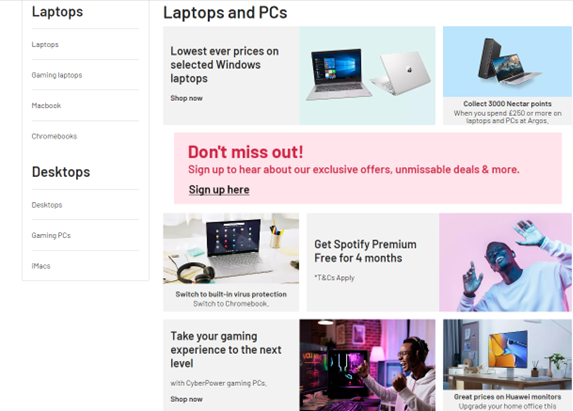SEO For eCommerce Blog Series Part Two: Site Architecture, Categories and Products

7th October 2022
This is part two of a six-part blog series on SEO for ecommerce websites. You can read the first instalment here: SEO For eCommerce Blog Series Part One: Why Does SEO Differ For eCommerce Websites? In this second article, we dive into some of the specific considerations required when optimising ecommerce websites for search engines. These include site architecture, category pages, product listing pages (PLPs), product details pages (PDPs), and PLP filters and sort options. Let’s get to it!
Website Architecture
Architecture is a fundamental part of SEO, in that it should be something you think about right from the very start when building your website. As we will see, there are several different page types you can use on ecommerce websites, and it’s important to get this structure right the first time so that you’re building on good foundations.
Technical and information architecture
There are two types of website architecture to discuss here – technical architecture and information architecture.
Information architecture is what we talk about when we discuss category pages and product listing pages, which we’ll go into in more detail later. Information architecture asks how your content is organised and what the wireframe of your website looks like. This may also cover your blog if you have one – how is it connected to the rest of your site? Is it integrated within it completely or is it on a subdomain? If it’s the latter, it’s important to create a good connection between the blog and the rest of your website.
Technical architecture covers things like where your server is in the world, what stack you are using, elements of the underlying code, the speed of your website and server, and the URLs of your pages.
Deep site architecture
Ecommerce websites are likely to have a deep site architecture. This means that the website pages are organised in several layers. For example, you might have several levels of category pages that your products sit under. You can find out more about this in our blog posts What Is Deep Site Architecture In SEO? and An Introduction to SEO Architecture.
Internal linking and breadcrumb trails
With a deep site architecture, it’s essential to have a good internal linking system and good navigation, including breadcrumb trails, to help both users and search bots find their way around your website (and to give more SEO link juice to your important pages). Breadcrumb trails help users see the scope of the website when they land on a page. Add to this, the structure of your URLs should reflect the structure of your website.
Category Pages
Now onto those different page types we talked about. The first one is category pages – not to be confused with product listing pages, or PLPs. PLPs are the types of page you see most often, and they are a list of products within a particular category. Category pages, however, are slightly different. A category page acts as a sort of homepage for a product type and it contains no links to individual products itself. Instead, it features links to product listing pages. This page on the Argos website, shown below, is an example of a category page. The Laptops and PCs category is too diverse to be able to show product listings on this page, as not all laptops and PCs share the same attributes. Instead, you can see that this page contains links to Windows laptops, gaming PCs, Huawei monitors, and much more as you scroll down.
Image

A pure category page therefore does not contain any filter or sort capabilities, because these are features of product listings. Category pages tend to be needed on larger websites that have lots of products in each category, for example a home electronics retailer with (among lots of other categories) 1,500 televisions, 700 cameras, 300 printers, and more. Another example of category pages could be manufacturer pages, which provide links to various PLPs that cannot share the same attributes.
When creating a category page, consider this: “If this website only sold X (for example televisions), what would the homepage look like?” That’s a guide for what a category page should contain - not only links to PLPs, but also blog posts, reviews, guides, and so on.
Pure category pages are less common these days, but what is more common is a “hybrid” category and PLP. It’s important to think about category pages, PLPs and site structure during the build of a website as it can be difficult to incorporate a new structure once the website is created.
Product Listing Pages
As explained above, product listing pages, or PLPs, are pages that list products within a category, and there is plenty we can do to optimise these pages.
PLP intro text
The intro text at the top of your PLP is a great opportunity for adding some SEO keywords, and if you don’t have intro text here, you could be missing out. In a paragraph such as this, you can explain a little about the products to get some keywords into your copy and help customers understand what product they need. You can also improve your SEO for other pages, as well as user navigation, by linking to popular manufacturers, buying guides, or PLPs narrowed down by specific attributes.
You could also put a paragraph like this at the bottom of the page, as if a user has gotten that far they may not have found what they are looking for. In that case, links to buying guides may be particularly useful.
You can also optimise your intro text for featured snippets, which you can read more about in our blog post How to Optimise Your Website for Featured Snippets.
PLP structure
You should also consider the structure of your pages. What information will the user want to see before clicking on a product? For example, the price, photo, and perhaps a description or some basic attributes such as size and colour, depending on the product. If you do add a description and this is pulled through from the product page automatically, check if this contains they keywords you want to target, and make sure the descriptions make sense and aren’t cut off mid-sentence.
Sort and filter options
It’s important that your faceted search or your sort and filter options are useful to humans and also look good from a technical SEO point of view. Can users sort by price, newest product and so on? Are the pages these sort and filter options create crawlable, and do you want them to be? Can spiders get lost or create billions of URL combinations? Finally, how do the selected sort options affect the page titles and headings? For example, if the user filters the laptop category to only include HP laptops, does the heading and page title change from “Laptops” to “HP Laptops”? If not, you could be missing out on keyword opportunities – but you don’t want an extremely long title to be generated if a user selects several filter options! These are all things to consider when building these pages.
Product Detail Pages (PDPs)
Product detail pages, PDPs, or simply product pages, are just what you would expect – the page for one specific product. Here are some things to consider when optimising this page type:
- Product description: Is the information unique and not copied from the manufacturer? If you’re using manufacturer information, you’re probably not the only one, and therefore you aren’t differentiating yourself from the competition in the eyes of Google’s algorithm or your users. Take the opportunity to say something unique about the product and make sure you’re selling the benefits to the customer, rather than simply stating the features. Is there enough detail in the write-up? Consider what the customer or your chosen personas want to know.
- Images: Are there enough photos of the product and are they good quality? We’ll talk about images in more detail in a future blog post.
- Added extras: Consider adding reviews, prices, different variety options, suggestions such as “people also buy” sections or related items, alternatives to out of stock products, relevant offers, delivery costs and details, and more to your product pages to give customers all the information they need. User-generated content such as reviews and photos are a good way of adding unique content to PDPs, and we’ll talk about this more in a future article.
Product Listing Pages Filters & Sort Options (Categories & Attributes)
Finally, let’s take a closer look at those PLP filters and sort options, or attributes. Here are some simple housekeeping questions to ask yourself when looking at these, to ensure your website is tidy and makes sense to both users and search engines:
- Are the attributes all relevant to the products listed?
- Are there duplicates or redundant attributes, or categories with similar names or meanings nested underneath each other?
- Do the attributes contain keywords where relevant?
You may also want to think about which attribute search pages you want to be indexed.
That covers our category pages, product listing pages, product detail pages, and filter and sort options. Next time we’ll be looking at user experience, including user intent, page speed, on-site search, and images. See you then!






